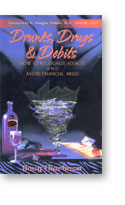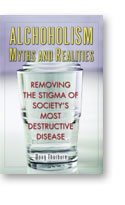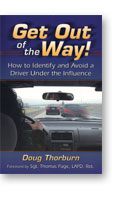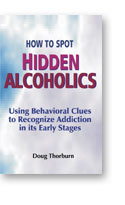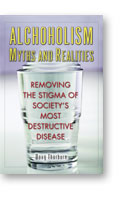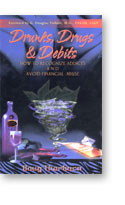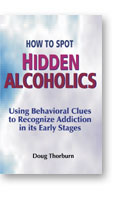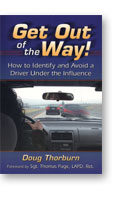 |
|
Issue #62 - February/March 2011
|
|
Because of the billions of options on the Internet, it’s become far more difficult to successfully advertise this letter. We’d really appreciate your forwarding it to family, friends and associates to give them the opportunity to subscribe.
|
|
Welcome to the Thorburn Addiction Report in which we interpret the news through the lens of alcohol and other drug addiction. Each month, we bring you several sections, including:
1. Top Story of the month along with runners up, persons under watch, enablers, disenablers and more
2. Review or Public Policy Recommendation of the month
3. Dear Doug in which a recent letter to "Dear Annie" or other "help" column is rewritten, with responses given from the unique perspective that alcohol or other drug addiction best explains the misbehaviors described
4. Alcoholic Myth-of-the-Month
5. Alcoholic Antic-of-the-Month, usually where someone deserves the Darwin Award, but lived.
There is something for everyone!
Addiction Report Archives here
|
|
The blog is open to your comments. We’ll be interested in any thoughts you, our loyal readers, may have.
Books Here
|
|

Charlie’s Enablers
Many writers and talking heads “get it” in regards to Charlie Sheen: plain and simple, he’s an addict. Some, however, could easily mislead the addiction unaware, including USA Today and its sources.
A USA Today article, “Charlie Sheen in the hottest of seats,” cites Vanderbilt School of Medicine in Nashville psychiatrist, Paul Ragan, explaining Charlie’s behaviors: it “strongly resembles a classic manic episode. What do we mean by a manic episode? This constant pressure to speak, the giving of numerous interviews, the increased goal-directed activities, irritability, lack of impulse control, what we call the ‘flight of ideas’—skipping from topic to topic, clearly the lack of judgment about his own issues. There’s the aggressiveness, the hostility.”
While this is a very accurate description of Charlie’s behaviors, Mr. Ragan fails to mention that all of these are common in alcohol and other-drug addicts and such addiction is by far the best explanation for their appearance. Such an omission is inexcusable for a so-called expert.
The piece goes on to quote chief psychologist at Maimonides Medical Center in Brooklyn, Alan Hilfer, who said, “There’s a grandiosity to [Sheen’s] statements that would worry most in the mental health profession.”
Such grandiosity concerns those in the addiction profession, Mr. Hilfer. The failure to even use the term will make many people think if Sheen were treated for a mental disorder, all would be well. Failing to identify the most common root to grandiosity is inexcusable for a so-called expert.
Then there’s professor of psychology at Hunter College in Manhattan, Jeffrey Parsons, who is quoted as saying, “My hypothesis is that it’s one of two things: It’s either an underlying bipolar disorder (a mental illness in which people cycle from depressive lows to euphoric highs) or it’s the result of long-term substance abuse and addiction.” (Emphasis added.)
Or? And? How about, “Given Charlie Sheen’s longstanding history of alcohol and other-drug addiction, he is exhibiting behaviors that mimic bipolar disorder. However, it’s obvious which came first. Addiction often mimics this disorder, as well as virtually all the others.” Giving credit where due, Parsons admits that bipolar disorder resembles symptoms of long-term substance “abuse” and that “even if he’s not actively using now, the long-term effects could still be driving his behavior.” True, but it’s not “abuse.” It’s clear-cut addiction and Parsons, if he hopes to help better educate the public about this often-fatal disease, should say so.
After having partially redeemed himself, Ragan completely screws it up. He estimates about 60% of bipolar patients also “abuse” drugs or alcohol (sic: should be “alcohol and other drugs”), often to “self-medicate.” He fails to mention that 70-80% of psychopathological disorders found during the first 10 days of sobriety disappear with three months of recovery (from studies cited in Drunks, Drugs & Debits: How to Recognize Addicts and Avoid Financial Abuse) and that tens of thousands if not millions of addicts, including actress Vivien Leigh, Mayo Methot (Mrs. Humphrey Bogart number three), poetEdna St. Vincent Millay, actresses Mary Tyler Moore and Frances Farmer, and writer Mary Ann Crenshaw have been wrongly diagnosed as bipolar, or schizophrenic, or sociopathic. Nor do they have borderline personality disorder, with which so many (including the addict who inspired me to learn about addiction) have been tragically misdiagnosed. They cannot be successfully treated, as Ragan claims, for “dual diagnosis,” because alcoholism, which causes brain damage, mimics or triggers what look like—but aren’t—personality disorders (thoroughly discussed in Alcoholism Myths and Realities: Removing the Stigma of Society's Most Destructive Disease). On the rare occasion when the disorder exists—for every one or two having a true disorder, at least ten have addiction—there is absolutely no way to know until the addict is clean and sober for at least a few months and possibly several years, after the alcoholism-damaged brain has at least partially healed.
Like all addicts who look like they’re unhinged, Charlie Sheen needs to be treated for the underlying disease: alcohol and other-drug addiction. Stop the euphemisms, the misdiagnoses, the excuses. Charlie Sheen may never get sober because fame, money and status (business, social and economic) are the greatest enablers. We only increase the odds of early demise by denying we can diagnose by observing him, as so many supposed medical professionals have been doing, explaining his plight by sidestepping the obvious and by showering him with attention. For Charlie Sheen’s sake, stop.
Thorburn Addiction Report Archives
|
|
Runner-up for top story of the month:
Actor Charlie Sheen. Again. Sigh….This time, after romping with several hookers on a cocaine-fueled orgy and, well…unless you live in North Korea, you know the rest. What else needs to be said, other than “Charlie, stop playing Charlie Harper. You’ve been sober before and you can do it again. It’s time, before you end up six feet under.” Unfortunately, he’s got too damned much money, at least until he spends it all on “goddesses” and cocaine.
Mohammar Gaddafi (AKA Khadafy), whose rambling diatribes are not dissimilar to those of Charlie Sheen’s (the only real difference is the subject). One interpreter reportedly said, “I just can’t take it any more,” after having gotten lost in translation. Another said, “He’s not exactly the most lucid speaker. It’s not just that what he’s saying is illogical, but the way he’s saying it is bizarre.” Gaddafi’s claim that protestors against his regime are fueled by milk and Nescafe spiked with hallucinogenic drugs by Islamic terrorists perhaps qualifies as a bit more than “bizarre.” The same interpreter said Gaddafi has a habit of repeating the same phrase over and over. (Sort of like Charlie Sheen’s “tiger blood and Adonis DNA,” below under “quotes of the month.”) Another interpreter said that his extemporaneous ramblings are a particular challenge: “Sometimes he mumbles, sometimes he talks to himself.” All are very similar to an amphetamine and barbiturate addict named Adolf Hitler.
By way of comparison, the form addiction takes is a function of environment, circumstances, personality type and position of power. At the risk of inflaming Charlie Sheen’s supporters—and I am one who hopes only that he gets clean and sober before tragedy happens—I would suggest that the difference between Sheen as he is now and Gaddafi is environment, circumstances, personality type and position of power. Therefore, we should not be surprised by anything Charlie does so long as he is not clean and sober. Remember Phil and Brynn Hartmann.
Author James Fogle, pleading guilty to the May 2010 robbery of a Redmond, WA pharmacy in which he and a partner tied up several employees and filled trash bags with drugs. Fogle, 73, knew something about the subject when he wrote the book Drugstore Cowboy, which was made into the critically acclaimed 1989 movie starring Matt Dillon: he was in the Walla Walla Washington State Penitentiary at the time of the movie’s release, serving time for exploits similar to those of the addicts he portrayed roaming around the Pacific Northwest robbing drugstores.
Enablers of the month:
One of “the key crew members on the set” of “Two and a Half Men,” who was “furious” with actor Charlie Sheen for halting the show’s production while completing rehab, because “A lot of us do not get paid if we don’t work. So if he’s off getting rehab or porn-o-ing or whatever, we’re screwed.” You idiot. If Sheen dies, you’re really screwed. The best thing that could happen would be for Sheen to get clean and sober, for the show’s writers to portray Charlie Harper as getting clean and sober, a couple of years of comedy and antics while he goes through rehab and AA meetings and then end the show. The current stories are getting mean and sophomoric; Alan and Jake have been transforming into asses (which is not inconsistent with being seriously affected codependents, so it’s pretty realistic) and we can see by Charlie Sheen’s facial contortions that he relapsed about two years ago. All good things must end. We can only hope this doesn’t end in tragedy.
Disenablers of the month:
Afra Sandifar, who while watching the evening news blurted out to her husband of six months, Troy Sandifar, 45, “Honey, you’re on the news for robbing a bank!” He immediately grabbed the loot and ran from his Manatee, Florida home; she called police and turned him in. Officers found Troy sitting in his car trying to eat the rock cocaine he’d bought with the cash. Afra said, “I’m not going to hide something like that. He needs to be sentenced and go into a program….”
The nine-year-old daughter of Latanya Evans, 49, who passed a note to a bank teller saying her mother was too drunk to drive and she didn’t want to ride in the car with her. When they left, the little girl refused to get in the car. While Evans drove off without her daughter, the teller reported the incident to police, who arrested the mother for DUI a short distance from the bank. Evans has had her license suspended five times, at least twice for DUI. She was convicted of child endangerment in 2002. Perhaps this very bright daughter has said she doesn’t want to live with her mother, but nobody is listening.
Elton John, scoffing at Billy Joel’s attempts at sobriety, telling reporters: “When I went to rehab, I had to clean the floors. He goes to rehab where they have TVs. I love you, Billy, and this is tough love.”
Quotes of the month:
Many of Charlie Sheen’s recent comments indicate an extraordinary degree of egomania and arrogance, which is almost always rooted in alcoholism. "I'm tired of pretending I'm not a total bitchin' rock star from Mars, and people can't figure me out; they can't process me. I don't expect them to. You can't process me with a normal brain." Explaining how he avoids relapse: "I just don't do it. I will not believe that if I do something then I have to follow a certain path because it was written for normal people. People who aren't special. People who don't have tiger blood and Adonis DNA." And a classic in the annals of egomania: “AA was written for normal people. People that don’t have tiger blood and Adonis DNA.”
Other Sheen comments indicate confabulated thinking, including such bizarre statements as: on his natural high: "I am on a drug. It's called Charlie Sheen. It's not available. If you try it once, you will die. Your face will melt off and your children will weep over your exploded body." On his dual personality: "I have a 10,000-year-old brain and the boogers of a 7-year-old. That's how I describe myself." The only brain he has is one damaged by longstanding substance addiction.
Sometimes, it takes an addict:
Gerry Rafferty, the Scottish singer and songwriter who gained pop culture status after director Quentin Tarantino included Rafferty’s “Stuck in the Middle With You” in the soundtrack of his 1992 film “Reservoir Dogs,” dead from liver failure at age 63. His most famous hit was “Baker Street,” from his solo No. 1 album “City to City.” His band Stealers Wheel had a “turbulent history” marked by legal battles and numerous personnel changes. Not surprisingly, he was reportedly “battling” alcoholism for much of his life.
Maria Schneider, the French actress whose character in the 1972 movie “Last Tango in Paris” engaged in an anonymous sexual relationship in an empty apartment with a grief-stricken middle-aged American (Marlon Brando) whose French wife had just committed suicide, dead after a long battle with cancer. Although Schneider confused cause and effect as most do (including even many addicts) by blaming the “glare of the media” for getting into drugs—“pot and then cocaine, LSD and heroin”—and that drugs were her “escape from reality,” she managed to get sober in 1980. Schneider was 58.
Note to family, friends and fans of the above: the benefit of the doubt is given by assuming alcoholism (they are either idiots and fundamentally rotten, or they are alcoholic/other drug addicts—which would explain the misbehaviors). If alcoholic, there is zero chance that behaviors, in the long run, will improve without sobriety. An essential prerequisite to sobriety is the cessation of enabling, allowing pain and crises to build. Thus far, many have done everything they can to protect the addict from the requisite pain, making these news events possible. The cure for alcoholism, consequential bad behaviors and, ultimately, tragedy, is simple: stop protecting the addict from the logical consequences of misbehaviors and, where possible, proactively intervene.
|
|

|
|

Modigliani: A Life, by Meryle Secrest
I often point out that motivations and lives of the subjects about whom biographers write can’t be understood without comprehending addiction. Modigliani provides yet more support for my assertion.
Secrest, who specializes in art-related biographies, thinks the artist Amedeo Modigliani’s public intoxication was mostly feigned and that he used drugs “medicinally,” as a “necessary anesthetic…to soothe his coughing fits” from his long-kept secret illness, tuberculosis. Yet, as described in Lance Esplund’s splendid review of the book in The Wall Street Journal, he insulted waiters, broke dishes and chairs, threw his mistress through a window and, when he was drunk, stripped nude in cafes and bars. He traded drawings for drinks and was a deadbeat dad who died friendless and alone.
Once addiction is understood, one needs very little information to ascribe high odds of the disease as the best explanation for misbehaviors and otherwise inexplicable attitudes. Any one of the behaviors alone gives high odds. The first line in the “product description” at Amazon.com is a quote suggestive of the classic arrogance of the addict: “People like us . . . have different rights, different values than do ordinary people because we have different needs which put us . . . above their moral standards.” The fact that this sounds like Charlie Sheen is no accident.
A far more accurate depiction of Modigliani is found in the 2005 movie by the same name, reviewed in the June 2005 TAR.
Click here to check out Doug's movie reviews.
|
 |
Co-worker’s drinking costs customers
Dear Doug:
I believe a co-worker’s drinking problem has cost her at least one customer and may cost her many more, culminating in being fired as sales manager. I’m concerned over confronting her, because it could destroy our professional relationship, which I value. Is there any way I can help without a direct confrontation?
Signed,
Concerned co-worker
Dear Codependent,
Other columnists would rightly say you may not be able to help your co-worker, directly or indirectly. If you are direct, you jeopardize your relationship and she may do nothing to change. However, such columnists might suggest that you are ethically-bound to honestly express your observations by saying something like, “I believe your drinking is interfering with your business. I believe in you, so I’m saying this out of concern for you.”
This isn’t bad, but “your drinking” isn’t the problem and the term needlessly assigns blame. The problem is the disease of alcoholism, which causes the afflicted to act badly some of the time. Instead, try this, which she won’t otherwise hear: “I believe, based on my observations of behaviors when you’re drinking, that you have the disease of alcoholism, which sometimes makes you act badly. I know you’re a better woman than that. I believe in the real you, not the false façade that may result in a loss of some of your customers. I’m concerned for you because I care.” You could also add that you know she hasn’t lost control over her drinking, but that when she drinks she has been known to lose control over her behaviors.
Don’t count on this care-frontation getting her sober. However, it could plant the seed that ultimately blooms into sobriety.
(Source for story idea: Ask Amy, January 20, 2011.)
PrevenTragedy Foundation
|
|
|

“A 2007 study by the U.S. Justice Department found that 56% of state prisoners, 45% of federal prisoners, and 64% of local jail inmates suffer from mental illnesses.”
So reported E. Fuller Torrey in a Wall Street Journal op-ed piece titled, “A Predictable Tragedy in Arizona,” in the wake of the Jared Lee Loughner murder of six innocent people while serious wounding Arizona Congresswoman Gabrielle Giffords and 11 others. Torrey wrote, “Ultimately, it is important to hold state officials responsible for not providing sufficient resources to treat those who suffer from serious mental illnesses.” That would be fine, E. Fuller Torrey, if that were the root of the problem. Unfortunately, depending on the study 50-90% of prisoners at all levels have alcohol or other-drug addictions, which happen to mimic serious mental illnesses. In fact, at least 70% of addicts with only three months of sobriety who were previously diagnosed as having a disorder can no longer be so diagnosed. If you’re going to solve the problem, you need to correctly identify it. The criminal justice system is in an excellent position to deal appropriately with addicts: forcibly keep them off drugs, which can be done via regular and random testing and a “sure” ride back to jail when tests are failed.
|
|

Stories from “This is True” by Randy Cassingham, with his “taglines:”
“SCHOOL OF HARD KNOCKS: A South Elgin, Ill., man is accused of hitting another man in the face with a glass while the two argued about whose school was better. According to police, the men, who met for the first time that night, were arguing when Kevin M. Page, 36, threw a bar stool into the bar, then grabbed a beer glass and hit the other man in the face with it. The victim suffered only minor scrapes. Page was charged with felony aggravated battery with a deadly weapon, felony aggravated battery in a public place, and criminal damage to property. Police didn't know which schools were the subject of the argument. (JW/Daily Herald) ...And the schools involved hope word never gets out.”
“IT'LL COME TO ME: Two drunk men got into a knife fight in Monroe County, Penn. Karl William Brown, 36, allegedly stabbed his friend [with a steak knife] after the two had been drinking heavily at another friend's house. Brown left the house after the incident, but later he remembered enough to call police and confess to the assault. The victim, James Barbagallo, was treated at the hospital and released with non life-threatening injuries. Brown was charged with felony aggravated assault, recklessly endangering another person and simple assault, and was held on $50,000 bail. What was the fight about? Both men say they can't remember. (JW/Lehigh Valley Express-Times) ...The reason for the stabbing is obvious: Brown was just testing to see if Barbagallo was ‘done’.”
Very often, both participants to a dispute have alcoholism—a disease that causes the afflicted person to act badly, some of the time. Misbehaviors take many forms, one of which is violence, especially after a heated argument, often over nothing important. It’s unimportant because the crux of the issue is who is right, regardless of the triviality of the subject. It doesn’t get much more trivial than which school is better, but I suppose an argument over something that neither party can remember takes the cake.
(Stories and taglines from “This is True,” copyright 2011 by Randy Cassingham, used with permission. If you haven't already subscribed to his newsletter—the free one at least, or the paid one I get, with more than twice the stories—I highly recommend it: www.ThisIsTrue.com.)
|
Comments
To view reader's comments on last month's Thorburn Addiction Report and Doug's responses please visit the Thorburn Weblog at PrevenTragedy.com.
Thorburn Blog
|
Doug's new book, Alcoholism Myths and Realities, is now available at
GaltPublishing.com, Amazon.com and bookstores near you.
"Every policymaker in America needs to read your book exposing the myths of chemical addiction...Excellent book."
— Jim Ramstad, Member of U.S. Congress (MN)
"My father died of alcoholism. His father died of alcoholism. Three generations of alcoholism is enough. Now is the time to abandon superstition and pseudoscience, to debunk the myths surrounding alcoholism, and to apply science to solving this problem. Doug Thorburn's book is a model example of how this should be done. Read it and be prepared to change your thinking on this important topic. When enough of us understand what is really going on with alcoholism, society can make the shift from treatment to prevention and intervention."
— Michael Shermer, publisher, Skeptic Magazine and columnist, Scientific American
Buy your copy of Alcoholism Myths and Realities for only $14.95 or get the whole collection PLUS a two-hour audio cassette from Galt Publishing for just $49.95 plus tax and shipping. That's a $72.75 value for only $49.95.
To order online, click the following link (be sure to put "TAR SPECIAL" in the comments section of the order form.) Orders can also be placed by phone: 800-482-9424 OR fax: 818-363-3111.
If you wish to pay by check, send the appropriate payment with your shipping information and the words "TAR SPECIAL" in the "memo" section of your check to: PO Box 7777, Northridge, CA 91327.
Click here to purchase any of the above Thorburn books
|

Have you visited the Prevent Tragedy Foundation" The Prevent Tragedy Foundation is a tax-exempt 501c-3 organization, the goal of which is to educate the general public on the need for early detection of alcohol and other drug addiction. The Foundation is intended to answer a question that has been all-but-ignored by similar organizations: what does alcoholism look like before it becomes obvious"
Click here to visit the Prevent Tragedy Foundation |
|
Subscriptions
The Thorburn Addiction Report is a free newsletter published by Galt Publishing and PrevenTragedy.com. Subscibe by visiting our web site at www.PrevenTragedy.com.
|
The Thorburn Addiction Report is available to newspapers as a regular feature column.
Inquiries are invited.
Copyright Doug Thorburn All Rights Reserved.
ALL broadcast, publication, retransmission to e-mail lists, WWW or any other copying or storage, in any medium, online or not, is strictly prohibited without prior written permission from the author. Manual forwarding by e-mail to friends is allowed if 1) the newsletter is forwarded in its entirety and 2) no fee is charged. Please forward no more than three issues to any one person -- after that, they should get their own free subscription. We appreciate people who report violations of our copyright to us.
TO COMMENT to the author,
send your email to report@preventragedy.com or write to
Doug Thorburn, P.O. Box 7777, Northridge, CA 91327-7777
|
 |



